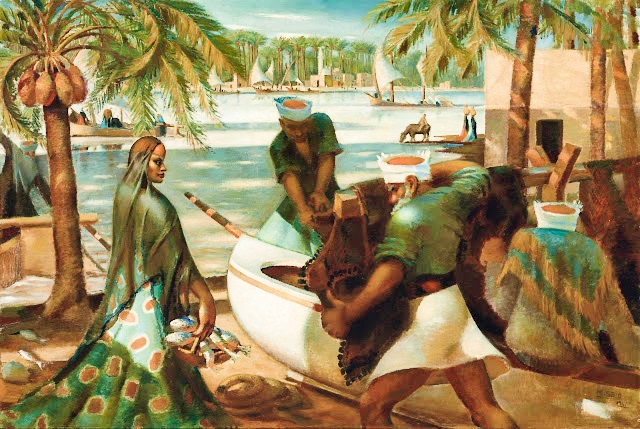Mahmoud Saïd (Egyptian, 1897-1964)
LE RETOUR DE PÊCHE (Fishing Returns), c. 1950
Oil on panel
35.5 by 37cm.; 14 by 14 1/2 in.
Private Collection
There is no doubt that the city of Alexandria had a resounding effect on the oeuvre of Mahmoud Said. A native of this great city, a number of Said’s paintings revolving around the rough seas and fishermen can be attributed to his hometown. Undeniably the most prominent example is La Pêche Miraculeuse from 1933, which is currently housed in the Egyptian Embassy in Washington D.C. Like the ships in the foreground aimlessly wandering the rough seas for the catch of the day, this theme of the search and the catch is also depicted very strongly in the present work Le Retour de Pêche. This stunning painting by Said is emblematic of the Alexandrian fishermen, who to this day can be seen on the eastern harbour of Alexandria, preparing their wooden boats to take on the rough seas. More on this painting
Mahmoud Saïd (Egyptian, 1897-1964)
La Pêche Miraculeuse (Miraculous Fishing ), c. 1933
Oil on canvas
90 x 120cm
Private Collection
Mahmoud Saïd (Egyptian, 1897-1964)
Pêcheurs à Rashid, Fishermen at Rashid (Rosetta), c. 1941
Oil on panel
34.25 in. (87.00 cm.) (height) by 50.39 in. (128.00 cm.) (width)
Private Collection
Rosetta or Rashid is a port city of the Nile Delta, 65 km (40 mi) east of Alexandria, in Egypt's Beheira governorate. The Rosetta Stone was discovered there in 1799.
Founded around in the 9th century, Rosetta boomed with the decline of Alexandria following the Ottoman conquest of Egypt in 1517, only to wane in importance after Alexandria's revival. During the 19th century, it was a popular British tourist destination, known for its Ottoman mansions, citrus groves and relative cleanliness.
More on Rosetta or Rashid
Mahmoud Said, 1897-1964, EGYPTIAN. Born into a wealthy Alexandrian family, Mahmoud Said first studied jurisprudence at the French School of Law in Cairo in the 1910s. During his studies, he became interested in painting, and joined the studios of Italian painters Amelia Casonato da Forno and Arturo Zanieri, before travelling to France to study in Paris, briefly at the Académie Julian. Though he worked for almost thirty years as a lawyer and then a judge, he continued to paint in his free time until he quit law in the late 1940s and devoted himself to art completely. He is considered the foremost painter of the ‘Pioneer’ generation of Egyptian artists, renowned for his bold, richly coloured portraits, nudes, and landscapes. He painted continuously until his death in 1964.
Said’s works are housed in private and public collections including Mathaf: Arab Museum of Modern Art, Doha; Museum of Modern Egyptian Art, Cairo; Mahmoud Said Museum, Alexandria, and Ministry of Culture, Egypt. More on Mahmoud Saïd
Please visit my other blogs: Art
Collector, Mythology, Marine
Art, Portrait of a Lady, The
Orientalist, Art of the Nude and The
Canals of Venice, Middle
East Artists, 365
Saints and 365 Days, also visit my Boards on Pinterest
Images are copyright of their respective owners, assignees or others.
Some Images may be subject to copyright
I don't own any of these images - credit is always given when due unless
it is unknown to me. if I post your images without your permission, please tell
me.
I do not sell art, art prints, framed posters or reproductions. Ads are
shown only to compensate the hosting expenses.
If you enjoyed this post, please share with friends and family.
Thank you for visiting my blog and also for liking its posts and pages.
Please note that the content of this post primarily consists of articles
available from Wikipedia or other free sources online.



No comments:
Post a Comment